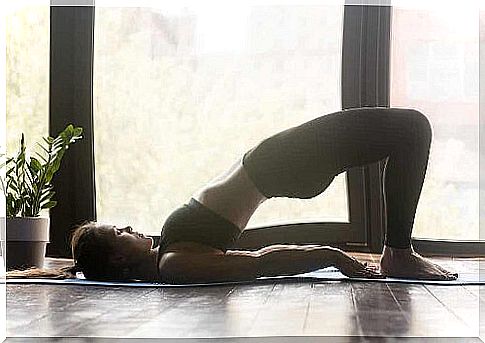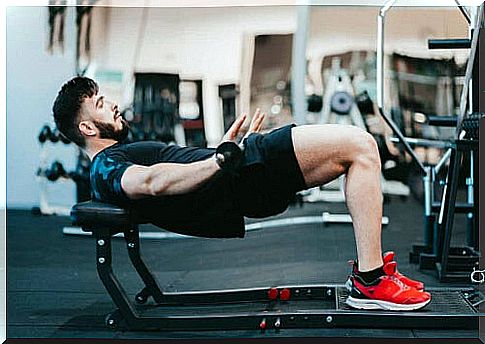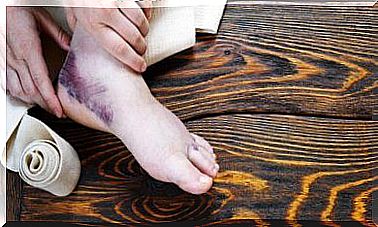Gluteal Bridge – 8 Options To Vary This Exercise

The gluteal bridge is a very versatile lower body exercise that works on the abdominal muscles, glutes, hamstrings and pelvic floor. This movement is ideal for improving hip mobility and strengthening your lower back. For more benefits, you can perform the gluteal bridge in a variety of ways.
The basic version is done lying on your back on the floor, with your knees bent and your feet propped up. From this position, with your arms at your sides, palms down, raise your hips until your knees, hips, and shoulders form a straight line.
Here the buttocks are pressed tightly, keeping the abdominal muscles taut so as not to stretch your back too much during the exercise. Hold the sternum position for a few seconds and then lower your back to the floor.
The gluteal bridge is an exercise that can be done in any muscle strengthening session. In addition, it is performed in such disciplines as yoga and pilates.
The buttock bridge and its variants that you can try
The brisket itself is already a good toning exercise. However , variations can be made to get additional benefits, making the exercise more intense and challenging.
To spice up the gluteal bridge, you can use additional equipment (such as balls or rollers) or not use any additional equipment. Here are some of the most interesting options.

1. The buttock bridge on one leg
It is a very simple way to diversify the gluteal bridge, but at the same time it is quite a challenge. It requires much more work on the leg and abdomen support side, while requiring additional work on an unsupported limb.
To do this exercise on one leg, lie on your back on the floor and bend your knees, resting your feet on the floor. Then lift one leg straight up, with your thighs parallel to each other.
In this position, push your hips up until your body is in a straight line from your shoulders to the toes of your extended foot. Go down slowly and repeat on the same side. Swap legs after 8 or 10 repetitions.
2. With raised heels
Another way to add variety to the gluteal bridge is to do it with elevated heels. It involves the work of the muscles: straight thighs, quadriceps, large medial and tailor’s muscles.
The buttock bridge on raised heels is done in the same way as a traditional bridge, but keeps the heels raised. Unable to count on a rebound, lifting requires more effort in the buttock area and more intense contraction of the core muscles.
3. The buttock bridge on the heels
In this variation of the buttock bridge, we only lean on the heels, lifting the front of the foot. This modifies the activation of the muscles and helps to engage or increase the work of the femoral biceps, semitendosus and slender muscles. Moreover, it engages more the gluteus muscles and the middle gluteal muscles.
The procedure is the same as in the previous exercise, but the fingers are avoided. Only the heels are used for support at all times.
4. The buttock bridge with a medicine ball
The gluteal bridge with the medicine ball is made by placing the feet together on the medicine ball so that the body must struggle to balance. The main challenge is the curved surface of the ball. Also, keeping your feet together makes it difficult to keep your hips up.
5. With a roller
Putting your feet on a roller is another variation of the buttock bridge. This is a bit easier because the feet can be supported at their normal width, but the instability of the roller and the small support area make it very difficult to do.
6. The buttock bridge on the bench
To add even more effort to the basic gluteal bridge, try placing your feet on an exercise bench, chair, or chest. This will allow you to lift your hips much higher and will be more difficult. In addition, you can make all the hardware-free variants explained above.
7. The buttock bridge with a barbell
Place the barbell on your thighs and support it. You can additionally weight it or use the barbell itself. Holding the stick will result in a loss of support, which will increase the difficulty level.
8. On the bench and chest
This time, rest your back on the bench and your feet on the drawer higher than the bench. Then do a basic exercise. You will see that the challenge is not easy and that stability requires concentration because it is easy to lose.

Assess your skills to spice up your gluteal bridge
The Basic Gluteal Bridge is not a difficult exercise, but it does require a certain level of endurance and strength. In addition, it is important to remember that correct technique is essential to prevent injuries.
For example, if you don’t activate your core and pelvic floor muscles properly, exercise causes stress on your lower back. Also, if you experience any back pain or trauma, especially in the lower part, it’s important to avoid this movement until the discomfort has passed.
As for the sternum variants, it’s important to include them carefully in your training and only do them when your physical form and endurance allow it. It is much better to do a basic exercise with more reps and sets than to introduce a more difficult exercise.









